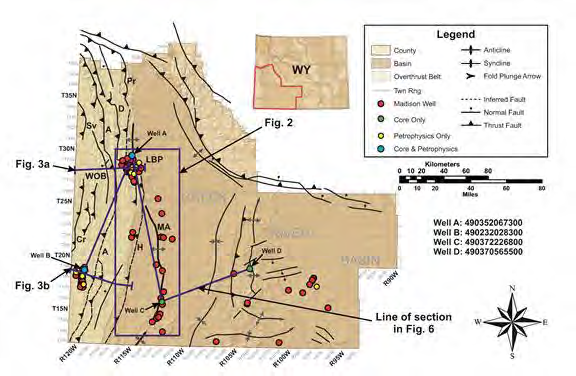- x
- Powder River Basin (Geological)
- Madison Formation
- Wallula Basalt Pilot
- Cropland (Terrestrial)
- Forestry (Terrestrial)
- Rangeland (Terrestrial)
Carbon Storage Atlas
Lat/Long
Regional map of the overall Big Sky Moxa Arch study area in western Wyoming showing the structural framework and wells available overlain on a shaded digital elevation model (modified after Dixon, 1982, Regional structural synthesis, Wyoming Salient of Western Overthrust Belt: American Association of Petroleum Geologists Bulletin, v. 66, p. 1560-158)
Why this Location
Given its apparent potential within the greater Rocky Mountain region as a possible large-scale storage target, this study provides a detailed examination of the petrophysical data for the Madison Group on the Moxa Arch, southwestern Wyoming. A portion of the study area is already a naturally occurring carbon dioxide (CO2) reservoir, supporting the idea that the Madison geology can provide safe, long-term storage.
Main Research Q&As Discovered
The Madison Formation, a reactive carbonate reservoir, has regions on the Moxa Arch that have been exposed to carbon dioxide (CO2) for millions of years in a naturally occurring gas reservoir. The objective of this field validation test was to determine changes in rock properties resulting from CO2 exposure. This task involved several investigations:
The data from the study area showed that there was little measurable effect on the reactive minerals, calcite and dolomite, even after long-term exposure and storage. The overall porosity and permeability was the same for sections of the formation that had not stored CO2 when compared to those areas that have CO2. Using the field data from the water and rock samples as a starting point, geochemical and reactive-transport simulations of the injection of 1 million tons of CO2 per year for 30 years into water-saturated Madison carbonate rock were performed to predict the effects of long-term storage and investigate the potential for leakage through likely caprocks. The geochemical and reactive-transport modeling predicted the same results, suggesting current models can accurately predict the general trends observed. The simulations showed that the Madison is capable of accepting the CO2 with little effect on the target formation.
- A geologic reservoir analysis was conducted to evaluate monitoring, verification, and accounting (MVA) performance at commercial-scale.
- A detailed design package for the field validation test was developed.
- Samples from pre-existing, CO2-exposed cores of the Madison Formation were collected.
- A petrographic analysis was conducted and core testing was done to assess changes in rock properties resulting from CO2 exposure.
- A geologic reservoir analysis of the site was conducted to identify the most likely leakage pathways.
Lessons Learned
The Madison Formation has been proposed as a major target for carbon storage. This extensive carbonate formation is present in several western states. In southwestern Wyoming, the formation contains natural carbon dioxide (CO2) deposits, suggesting that it has all the necessary properties to serve as a long-term storage repository. The formation was carefully characterized in locations with and without natural CO2 accumulation. The data from the study area showed that there was little measurable effect on the reactive minerals, calcite and dolomite, even after long-term exposure and storage. Simulations showed that the Madison Formation is capable of accepting the CO2 with little effect on the target formation. The carbonate rock was reactive only near the wellbore in the simulation, which matches the field observations from portions of the Madison limestone that have contained supercritical CO2 for millions of years.
Links to EDX
Reactive Carbonate Reservoirs Final Report
This document assesses the costs associated with separating the carbon dioxide (CO2) from flue gas and then injecting it into a coal seam. The technical challenges and costs associated with CO2 separation from flue gas and transportation of the separated CO2 from the point source to an appropriate storage target are also analyzed in this report




